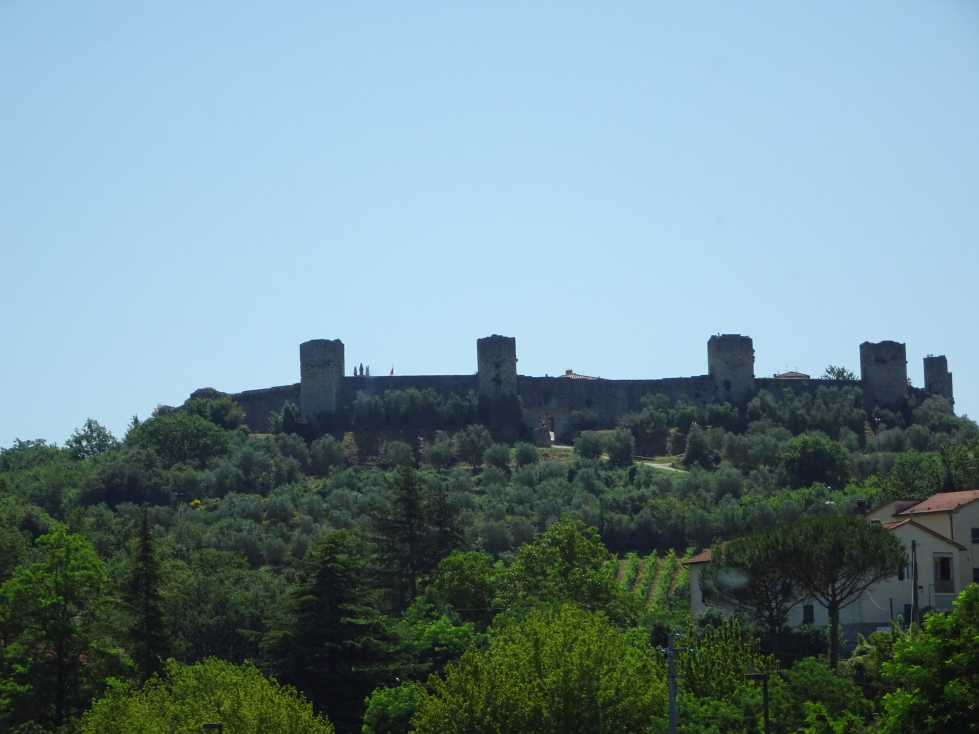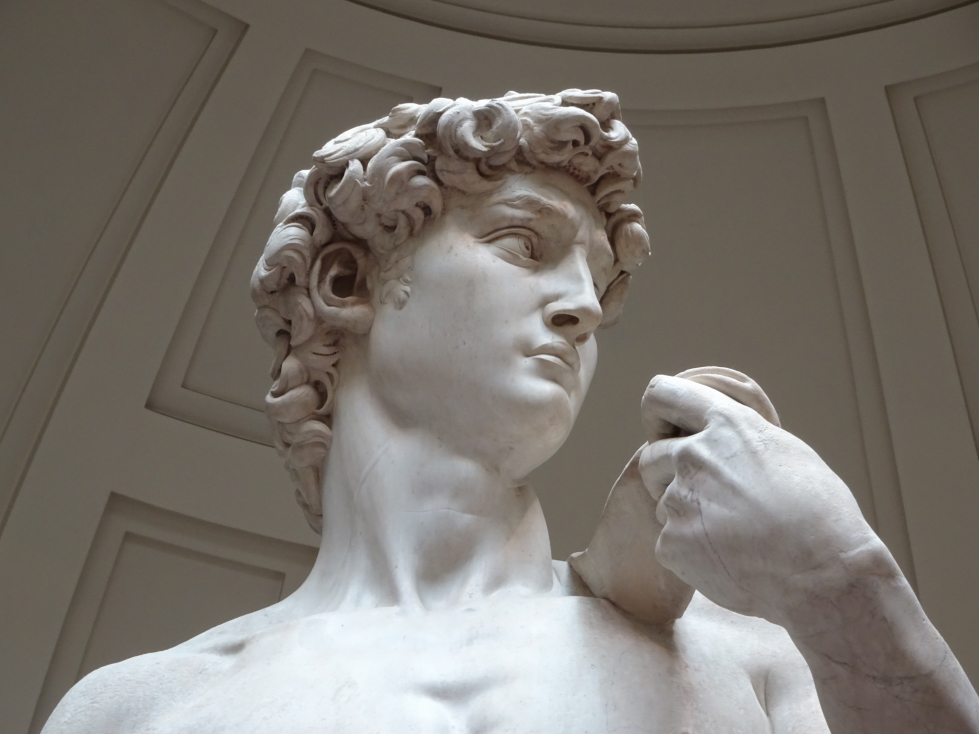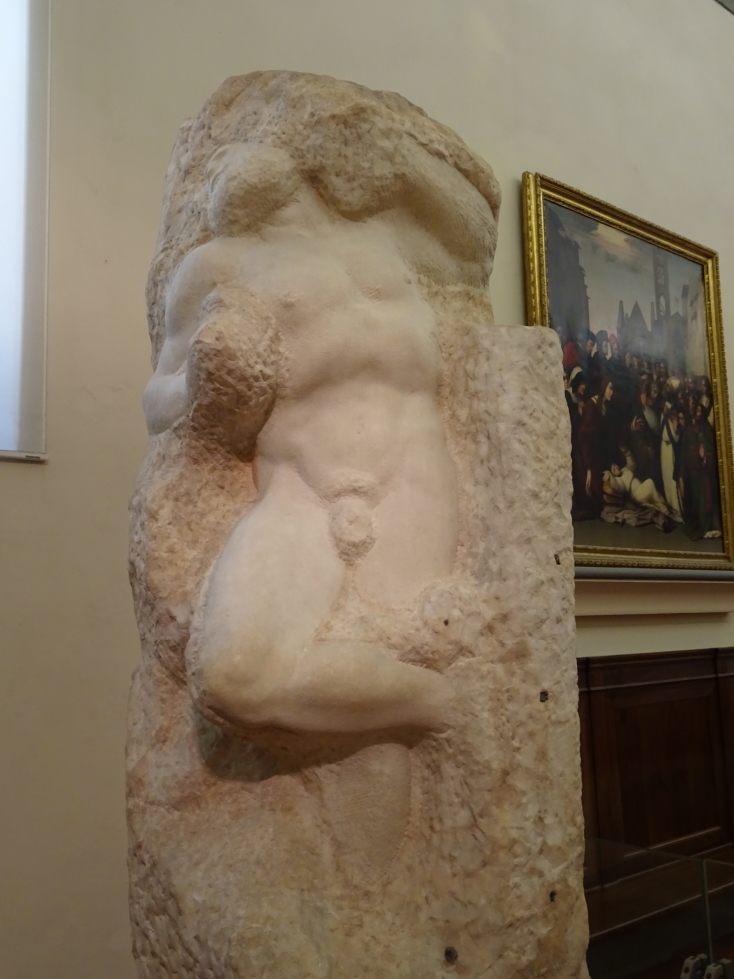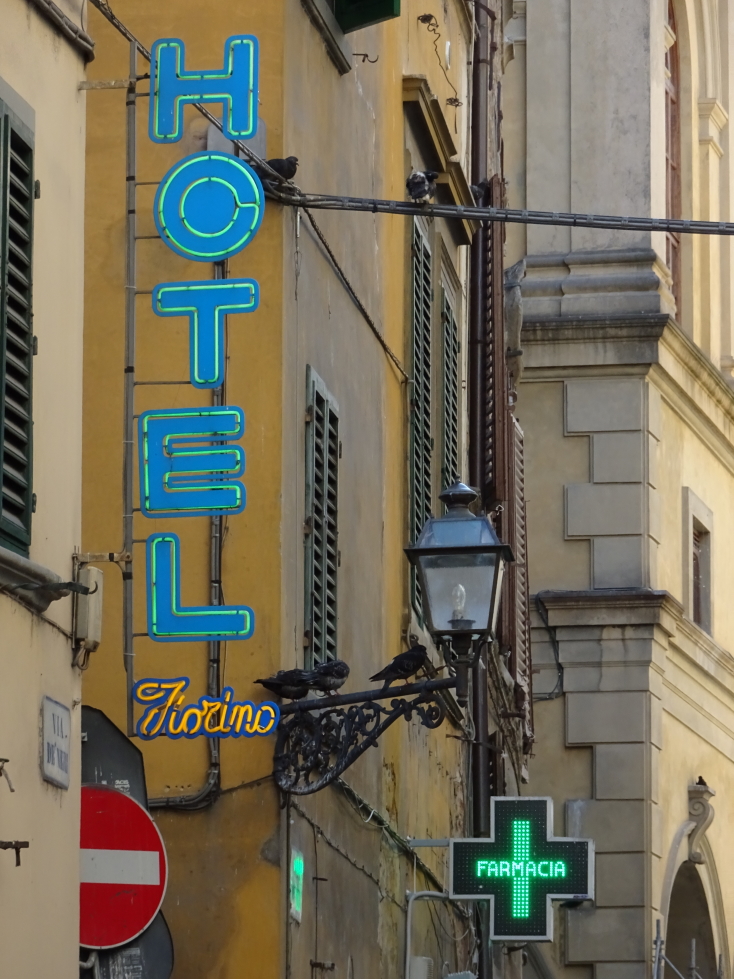Woke up unusually early, 6a. After a quick breakfast at the hotel we headed to the nearly adjacent Palazzo Vecchio for a self-guided tour. The first room we came to was massive, a great hall lined with paintings and overlooked by a second floor balcony. Tucked to the side was a small study, or studiolo, built by Francesco I de’ Medici in the early 1570s. It was lavishly painted floor to vaulted ceiling. The rest of the first floor had office for various Medici members.

Piazza della Signoria in the early morning light

Courtyard at the Palazzo Vecchio

Salone dei Cinquecento, the main room of the palace

Studiolo of Francesco I in Palazzo Vecchio
The second floor had rooms based on various elements as well as rooms depicting pagan Greek and Roman gods, goddesses, and myths. Past an impressive Hall of Lilies lay the most awesome room — the Hall of Geographical Maps. In the center of the room sat a large globe, surrounded by fifty three painted maps lining the walls. It was amazing seeing depictions of animals, real and imagined, in lands from all over the globe including the Americas. No Australia or Antarctica, however, as they hadn’t been discovered by Europeans by the late 16th century.

Hercules and the hydra from a second floor room

Cool ceiling in a chapel in the Palazzo Vecchio

Globe and maps in Palazzo Vecchio’s map room

Detail of a map of Egypt showing the Nile delta and a lion

Map of Greece and the Aegean Sea

Ornate ceiling in the Palazzo Vecchio
Dodging a large tour group we made our way to the excavations under the Palazzo. The rest of the family elected to pass the visit as there were uneven metal grates and stairs to navigate. The Palazzo was built on top of a Roman theater. There wasn’t a ton to see, mainly some foundations and parts of walls as well as a few statues and some pots and urns. There were neat shadow projections of performers and such to help bring the place alive.

Ruins of a Roman theater under the Palazzo Vecchio
Exiting the Palazzo we headed to the Piazza del Duomo and purchased tickets to the Duomo and other connected sights. After a surprisingly brief wait in line we entered the cathedral, formally known as Cattedrale di Santa Maria del Fiore. I’ll be honest, it is quite underwhelming inside compared to many of the cathedrals we had seen thus far. The walls are almost completely unadorned, left a uniform gray. The sparseness is in part because it was built with public funds and most decorations thus honor the civic leaders of Florence, such as a painting of Dante that shows a view of Florence in the late 1400s (long after Dante died) as well as scenes from the _Divine Comedy_. Also, quite a bit of the art pieces have been moved to the adjacent museum.

_Fountain of Neptune_ in the Piazza della Signoria

Vegetables on display in front of a shop in Florence

The sparse interior of Florence Cathedral

Painting of Dante in front of Florence and showing scenes from _Divine Comedy_
Despite the sparseness, however, the interior of the cathedral’s dome, or Duomo, was spectacular. It depicts _The Last Judgment_ over a vast 39,000 square feet. Though the product of several artists in the late 1500s using different techniques it still managed to look very impressive. There was also a funky 24-hour clock with I at the bottom and it even used IIII for four, VIIII for nine, etc.

Interior of the Duomo

Scenes from _The Last Judgment_ painted in the interior of the Duomo

More of the Duomo

Closeup of the interior of the Duomo’s painting, including some cracks

Twenty-four hour clock in the Duomo

Cool stained glass window in the Duomo
Once we were done with the cathedral proper we descended some stairs into the remains of the Roman houses (including mosaics from North Africa ca. 500!) it was built upon as well as the earliest Christian church, Santa Reparata, as well as subsequent expansions to the church. It had many graves of prominent Florentines including bishops as well as the tomb of Brunelleschi, designer of the Duomo’s dome. In an alcove were skulls, shin bones, and other relics in small glass chests. Several Medici artifacts like spurs were also on display, as well as a recreation of the original Christian altar that graced the small original church.

Foundation of the earlier church below the modern-day cathedral

Roman mosaic designed by North African craftsmen, ca. 500 AD

Cross set up on a recreation of an early Christian altar

Medieval grave

Exterior of the Duomo
For lunch we went to Panini Toscani, a very small sandwich shop right across from the Duomo. We waited on line for over half an hour and happened to be in line right behind a couple on honeymoon from North Carolina. They were visiting London, Florence, and Rome. He was a NCSU graduate student and she a UNC undergraduate and NCSU graduate. We talked about home as she hailed from Cary (having gone to Enloe Highschool), NCSU basketball, Brexit, etc. Finally making it into the shop were were treated to a demonstration of the choice of four cheeses and three meats. We then chose our meat, cheese, bread, and toppings. It was simply amazing, very tasty.

Panini Toscani, an amazing sandwich shop
We sat in front of the Duomo museum in the scant shade and ate our paninis. Genetta showed a little bit later and got her panini and Addison got a bit more. We watched pigeons pecking for crumbs (and tossed a few which they played with) and even pieces of meat (they didn’t like that) in the flagstones in front of us.
We headed back to the hotel about 2p while Michelle and Genetta went shopping. They returned between 2:30p and 3p as Michelle wasn’t feeling very good. I headed back out with them to finish shopping — Michelle got a leather bag and Genetta some tea — as well as a quick stop for gelato from a shop off of Via dei Neri.
I walked Genetta back to her apartment, observing some amusing graffiti of an octopus grasping a red car along the way. I then headed west a few hundred yards to the Piazza del Duomo and went through the Battistero di San Giovanni, or Baptistery of Saint John. Wow! In addition to ornate balconies with white and black marble was the real star of the show — the amazing ceiling. It depicted not only Jesus and saints and such but also a devil eating corpses. Metal! After I left I convinced Michelle to go through (she had been waiting outside as she didn’t feel well). Afterwards she headed back to the room, with me following soon after once I was done taking a couple of pictures of the outside, including the ornate (but reproduction) doors (the Porta del Paradiso, or Gates of Paradise).

Graffiti in Florence

Detail of the painted dome of the Baptistery of Saint John

Balcony in the baptistery

Closeup of Jesus in the baptistery
At about 5:30p I decided to head solo to the museum, rushing as I thought it closed at 7p. It turns out it closed at 9p, giving me ample time to enjoy. What a museum! The first room was three stories tall and had a reconstruction of the original cathedral facade (prior to the redesign in the 1500s — which was better than the subsequent redesign in the 1800s) with some of the original stonework and statuary excavated over the years. They also had the Roman sarcophagi that graced the area between the cathedral entrance and baptistery. Of note too were the three original baptistery doors, moved to the museum to protect them from the elements.

The Gates of Paradise, doors from the baptistery

Detail of the baptistery doors

Large hall containing reconstruction of the original cathedral facade
They had a disappointing la Pieta but much of the rest of the artifacts in the museum were very impressive. One gallery housed a series of diamond and hexagon “medallions” displaying professions and people that once lined the bell tower or Campanile. Another gallery had large wooden models of the dome built to help in the actual construction as well as models from other designs that lost the competition. Maps showed where timber was harvested from Church-owned lands in the countryside surrounding Florence.

Hall of medallions taken from the Campanile

Diamond medallion, love the blue tile work!

Hexagon medallion of a cartographer

Model of the Duomo
Later rooms housed vestments, scepters, music books, and an ornate silver altar with miniscule details. There was also a nice terrace affording decent close views of the dome. Walked back to the room just before 8p. Suddenly horns were blaring, guys cheering and shouting and running in and out of the bars lining the street — Italy had defeated Spain 2-0 in the round of 16 of Euro 2016.

Silver altar from the cathedral

Detail from the silver altar

The Duomo from the museum’s terrace

Palazzo Vecchio in the evening light
I convinced Addison at about 8:20p to make a mad dash across the Arno river and up a steep bluff to the Piazzale Michelangelo which afforded beautiful sunset views of the city. Once there we got some water and took a number of photos and enjoyed the evening breeze. Descending the hill shortly after dusk we passed a big screen next to the river showing Iceland versus England, Iceland winning in a massive 2-1 upset. We stopped at Lungarno 23 for dinner (yes, again). Addison and I both had bacon cheeseburgers with fries and got takeout for Michelle — Lungarno 23 salad and Coke.

Abbazia di San Miniato al Monte shining with the setting sun

Florence skyline at sunset

Bridges over the Arno lit by the setting sun

Another view of Florence at sunset

Closeup of the Duomo from Piazzale Michelangelo

I still have NO idea what this sign is trying to communicate!
We got back to the room just before 11p. Michelle really liked her dinner, made her feel a bit better. I picked up the laundry and refilled our water bottle at the fountain in the Piazza. Transferred photos from the cameras and blogged for a bit, heading to bed at about 1:30a. What a busy day!

























































































































































































